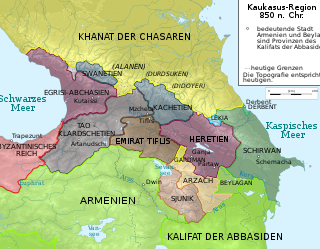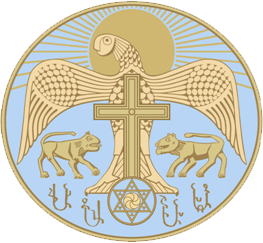Related Research Articles

Caucasian Albania is a modern exonym for a former state located in ancient times in the Caucasus: mostly in what is now Azerbaijan. The modern endonyms for the area are Aghwank and Aluank, among the Udi people, who regard themselves as descended from the inhabitants of Caucasian Albania. However, its original endonym is unknown.

Artsakh was the tenth province (nahang) of the Kingdom of Armenia from c. 189 BC until 387 AD, when it was made part of Caucasian Albania, a subject principality of the Sasanian Empire, following the Peace of Acilisene. From the 7th to 9th centuries, it fell under Arab control. In 821, it formed the Armenian principality of Khachen and around the year 1000 was proclaimed the Kingdom of Artsakh, one of the last medieval eastern Armenian kingdoms and principalities to maintain its autonomy following the Turkic invasions of the 11th to 14th centuries.

Arran, also known as Aran, was a geographical name used in ancient and medieval times to signify a historically-Iranian region which lay within the triangle of land, lowland in the east and mountainous in the west, formed by the junction of the Kura and Aras rivers, including the highland and lowland Karabakh, Mil plain and parts of the Mughan plain. In pre-Islamic times, it corresponded roughly to the territory of the modern-day Republic of Azerbaijan. The term is the Middle Persian equivalent to the Greco-Roman Albania. It was known as Aghvania, Alvan-k in Armenian, and Al-ran in Arabic.

The Kingdom of Hereti was a medieval monarchy which emerged in Caucasus on the Iberian-Albanian frontier. Nowadays it roughly corresponds to the southeastern corner of Georgia's Kakheti region and a portion of Azerbaijan's northwestern districts.

The Principality of Khachen was a medieval Armenian principality on the territory of historical Artsakh. The provinces of Artsakh and Utik were attached to the Kingdom of Armenia in antiquity, although they were later lost to Caucasian Albania. In the early medieval period, these provinces were under Sassanid and then Arab suzerainty until the establishment of the Bagratid Kingdom of Armenia in the 9th century. From the 12th century, the principality of Khachen dominated the region. The Byzantine emperor Constantine VII addressed his letters to the prince of Khachen with the inscription "To Prince of Khachen, Armenia."

Juansher was the Mihranid prince of Caucasian Albania, ruling the principality from 637 to 669. He was the son and successor of Varaz Grigor.

Barda is a city and the capital of the Barda District in Azerbaijan, located south of Yevlax and on the left bank of the Tartar river. It served as the capital of Caucasian Albania by the end of the 5th-century. Barda became the chief city of the Islamic province of Arran, the classical Caucasian Albania, remaining so until the tenth century.
Movses Kaghankatvatsi, or Movses Daskhurantsi is the reputed author of a tenth-century Classical Armenian historiographical work on Caucasian Albania and eastern provinces of Armenia, known as The History of the Country of Albania.

Hinduism in Armenia remains a minor feature in Armenian religious life, generally represented through The International Society for Krishna Consciousness and a minority of Indian students, with backgrounds in Hinduism.

Arakel Grigori Babakhanian, commonly known by his pen name Leo, was an Armenian historian, writer, critic, and professor at Yerevan State University. He is best known for authoring a multi-volume work on the history of Armenia. Leo adopted a critical stance in examining some of the most important issues in Armenian history, literature and contemporary problems of the early 20th century.

The Hasan-Jalalyans were a medieval Armenian dynasty that ruled over parts of the South Caucasus. From the early thirteenth century, the family held sway in Khachen in what are now the regions of lower Karabakh, Nagorno-Karabakh, and Syunik in modern Armenia. The family was founded by Hasan-Jalal Dawla, an Armenian feudal prince from Khachen. The Hasan-Jalalyans maintained their autonomy over the course of several centuries of nominal foreign domination by the Seljuk Turks, Persians and Mongols. They, along with the other Armenian princes and meliks of Khachen, saw themselves as holding the last bastion of Armenian independence in the region.
The Mihranids were an Iranian family which ruled several regions of Caucasus from 330 to 821. They claimed to be of Sasanian Persian descent but were of Parthian origin.

Caucasian Albania was a kingdom in the Caucasus, which was under the suzerainty of the Sasanian Empire from 252 to 636.
Sahl Smbatean Eṙanshahik was an Armenian prince of Arran and Shaki who played a considerable role in the history of the eastern Caucasus during the 9th century and was the ancestor of the House of Khachen established in 821.
Esayi Abu-Musa was an Armenian prince of southern Artsakh who ruled over a significant part of Arran in the mid-9th century and is considered the founder of the Principality of Dizak.
Davtak Kertogh was a 7th-century Armenian poet, the first secular writer in Armenian literature. He is the author of "Elegy on the Death of the Great Prince Jevansher", dedicated to the first Sassanid prince of Caucasian Albania, who accepted Christianity and was murdered.
Hovhannes Imastaser, also known as Hovhannes Sarkavag, was a medieval Armenian multi-disciplinary scholar known for his works on philosophy, theology, mathematics, cosmology, and literature. Imastaser was also a gifted hymnologist and pedagogue.
Prince Arran or Arhan was a semi-legendary founder of Caucasian Albania. The early Armenian historian Movses Khorenatsi tells of a certain Aran, a descendant of the legendary Armenian patriarch Hayk through Sisak. According to Movses Kagankatvatsi he was 9th generation descendant of Japheth. He is regarded as progenitor of Aranshahik dynasty. According to a legendary tradition reported by Khorenatsi, Arran was a descendant of Sisak, the ancestor of the Siunids of Albania’s province of Syunik, and thus a great-grandson of the ancestral eponym of the local albanians. Almost no information exists about him and his successors except names. He was contemporary of Abraham according to Movses Kagankatvatsi which seems to be a legend.

Vachagan IIIthe Pious or Vachagan II was the last Arsacid king of Caucasian Albania, ruling approximately from 485 to 523.
Arakel or Aragel, an Armenian given name. It means "To send" in Armenian. With the addition of -ian, it is also a common surname as Arakelyan / Arakelian.
References
- ↑ Agop Jack Hacikyan (2000). Agop Jack Hacikyan; Edward S. Franchuk; Gabriel Basmajian; Nourhan Ouzounian (eds.). The Heritage of Armenian Literature: From the sixth to the eighteenth century. Vol. 2. Detroit: Wayne State University Press. p. 166. ISBN 9780814330234.
- ↑ Arakel Babakhanian (Leo). Երկերի ժողովածու (Collected Works). vol. ii. Yerevan, Armenian SSR: Sovetakan Grogh, 1967, pp. 446- 449.